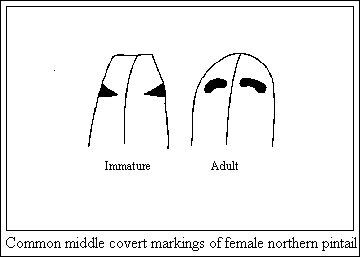
Tertials and scapulars are useful for identifying some males, but not for separating the sexes in all cases.
The tertial coverts of the immature plumage have conspicuous edging which is a light yellowish brown. Birds with such wings are immature males. Tertial coverts of the adult-type lack edging and are found on both adult and immature wings. Tertials that lack the black edging are immature. It seems likely that wings with new tertials growing after November are immatures.
The tertial coverts of the immature plumage are very frayed, often poorly edged and individual feathers are often long and narrow. The tertial coverts of adult-type plumage are not very frayed, are well rounded, and have conspicuous edging.

| Wing Character | Male | Female | ||
| Adult | Immature | Immature | Adult | |
| Scapulars | Vermiculated or barred or both | Barred | ||
| Underwing | Gray; heavily flecked with white | Alternate brown and white bars | ||
| Speculum | Iridescent green | Non-iridescent; bronze or (rarely) green | ||
| Tertials | Acutely pointed; brownish gray; without edging; black longitudinal stripe surrounding rachis | Brown; most distal with broad black stripe; others with pale stripe near rachis; often frayed | Brown with pale longitudinal stripe near rachis; well edged with pale color; often frayed | Bluntly pointed; dark brown; heavily edged with light brown; outer webs with brownish longitudinal stripe; sometimes slightly frayed |
| After molt: Similar to adult male | After molt: Similar to adult female | |||
| Greater tertial coverts | Entirely gray; mat be somewhat frayed; broadly rounded | Gray with pale edging; somewhat trapezoidal in shape; often frayed | Brown with pale edging; pointed; often frayed | Brown; well marked with pale edging forming a smoothly rounded arc |
| After molt: Similar to adult male | After molt: Similar to adult female | |||
| Middle and lesser coverts | Gray; without edging; sometimes heavily marked with light flecks; rounded | Gray; light brown edging at tips; sometimes lightly flecked; somewhat trapezoidal | Brown with light edging; often with paired triangular marking merging with edging; somewhat trapezoidal | Brown with light edging; often with paired internal oblong markings separated from edging; rounded |




